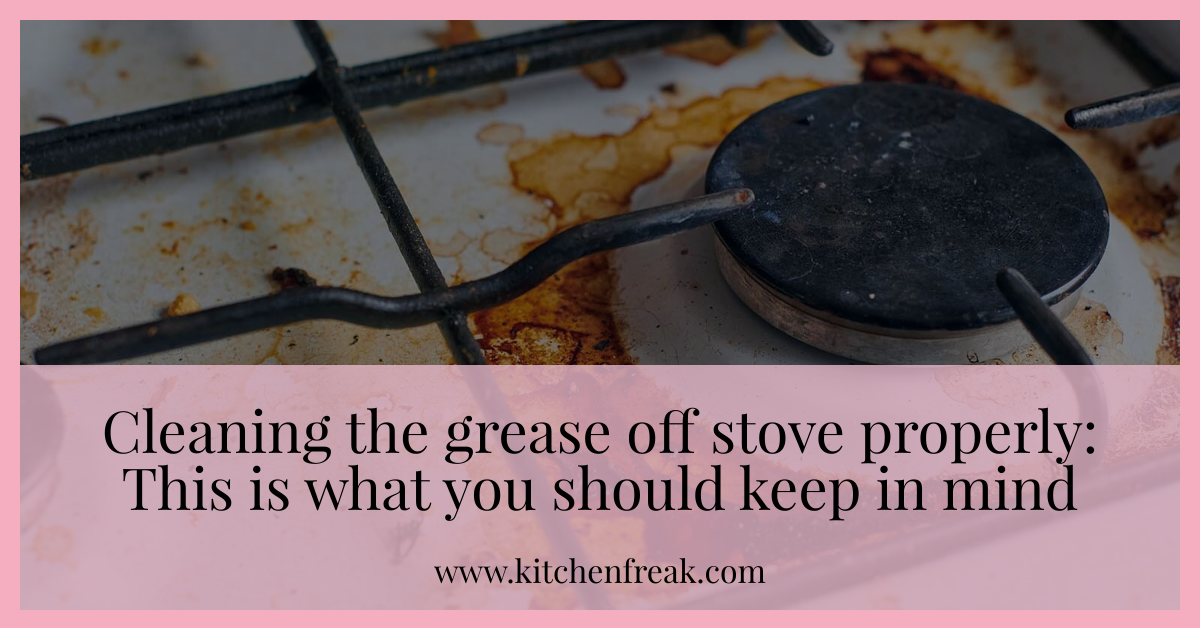A kitchen oven stands for traditional cooking and baking: the cracking wood creates a cozy atmosphere, the galley is pleasantly heated and the practical use is simply fun. However, proper care should not be neglected. Don’t forget to clean the greasy galley stove and hob regularly. Due to the use of different materials, different home remedies are sometimes required for scrubing, which can make the process more difficult. We will show you the most important care instructions so that you can enjoy your wood oven for as long as possible.
Table of Contents
Old vs. new galley stove: The most important differences at a glance
Depending on the year of manufacture, an old galley oven can differ from a new oven. Before scrubing, find out what materials were used for the paneling, oven top and viewing window. The cleansing agents used can vary accordingly. You can also often find instructions for scrubing in the enclosed instructions for use.
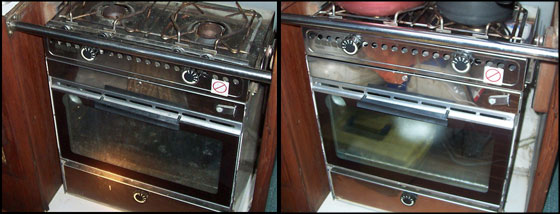
Cleaning an old galley stove: This is what you need to consider
Old, traditional galley ovens are preferably made of sturdy steel. The material is resistant to scratches and is usually easy to cleanse. If stubborn dirt still occurs, it can be removed with sandpaper or fine steel wool.
For an individual design, the steel body of the wood oven can be enamelled. Caution is advised here: Enamel is more sensitive than steel and should therefore not be scrubed with sandpaper or steel wool or with aggressive cleaners. Instead, use a soft sponge with a little soapy water to get rid of dirt from the coating.
What you need to consider when cleaning your new galley oven
In addition to steel, other materials are also used for new galley ovens. Cast iron or glass ceramic can be used for the cooktop. If the oven top of the wood oven is painted, you must under no circumstances scrub it with harsh scrubing agents. They destroy the paint and, in the worst case, can make the oven unusable.
Ceramic, natural stone, stainless steel or cast iron are most often used to cover the wood oven. In new ovens, the baking compartment and combustion chamber are often equipped with a glass window to allow a view of the fire.
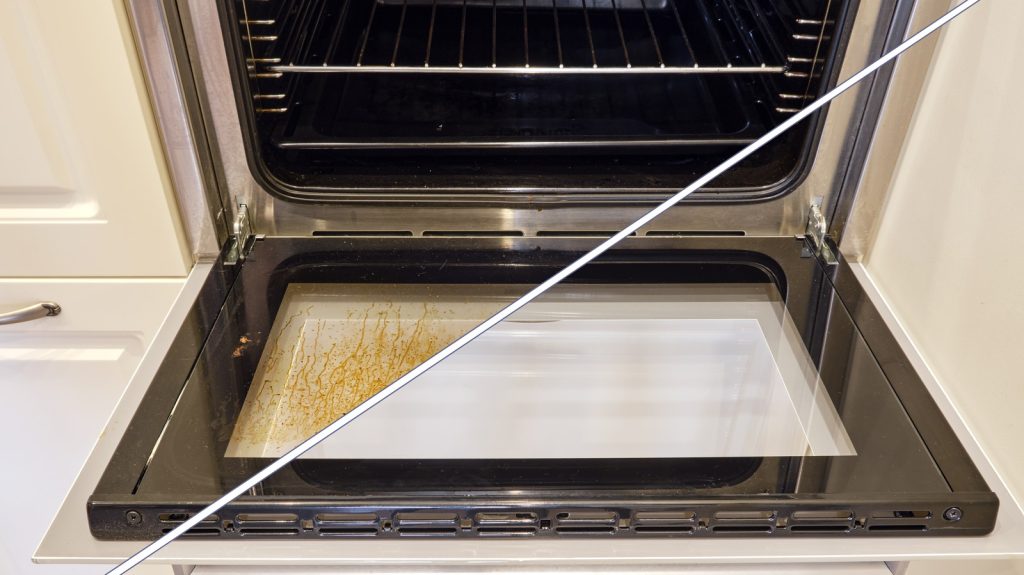
Cleaning your stovetop – this is how it works
Is the cooktop of your wood oven made of steel, cast iron or glass ceramic? Find out about the material used and follow our scrubing instructions.
Clean steel stove top
In both old and new galley ovens, the stove top can be made of steel. Conventional scouring milk is best suited for scrubing: simply put a little undiluted liquid on the cooktop and burner and rub in with a damp rag or sponge. Leave to take effect briefly, then rinse with clean water and cleanse dry. To prevent further contamination, you can lightly grease the cooktop with acid-free oils or special steel plate cleaners. Good to know: A steel cooktop is best cleansed when it is warm (not hot).
Clean cast iron cooktop
Rust and other contaminants can severely impact the performance of your cast iron cooktop. To protect the cooktop in the long term, grease it regularly with a neutral, heat-resistant oil.Fine sandpaper or fine steel wool are suitable for cleansing the cast iron stove top.
Caution: You should never touch enamelled or painted areas with it, otherwise further scratches will occur. In principle, you can remove dirt from the cast iron hob using standard scrubing products.
Cast iron oven tops are prone to rust. This not only doesn’t look good on the oven – it even damages the material. Rust eats into the cooktop and can make the cooktop uneven, requiring it to be replaced. That’s why you should cleanse your cast iron cooktop regularly and get rid of rust.
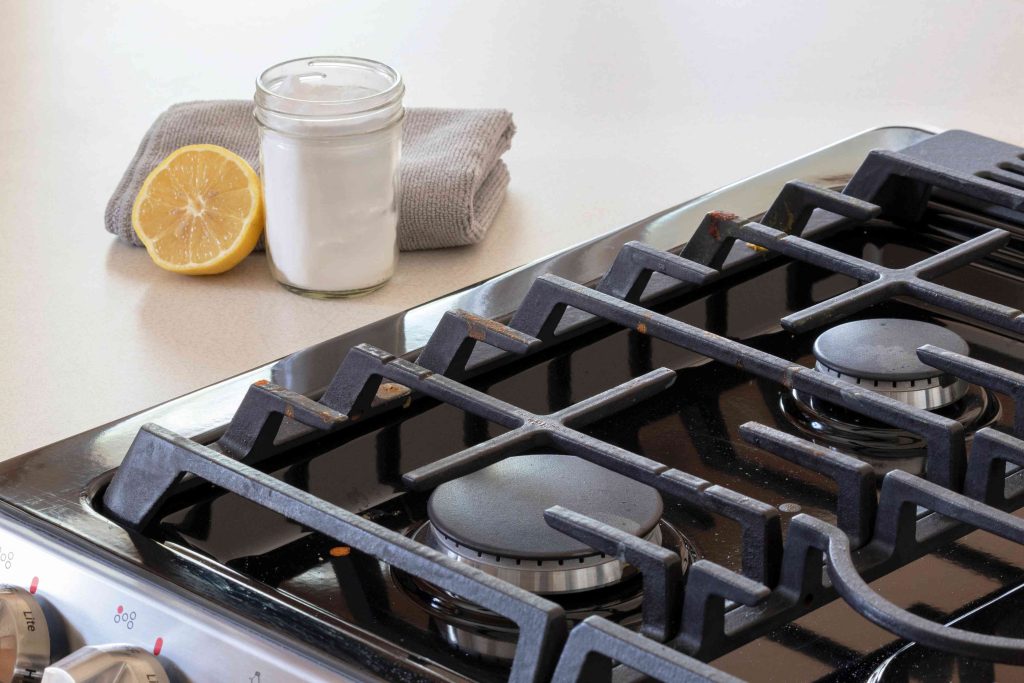
Cleaning a rusty cooktop: Here’s how to proceed:
- To scrub a rusty cooktop, apply a petrolatum, such as Vaseline, to the rusty areas. You can then cleanse the rust with a rag.
- For more stubborn rust, it’s best to use an abrasive detergent and steel wool. Alternatively, you can also use 100-grit sandpaper . Use this to carefully get rid of the rust.
- After getting rid of the rust, you can color the cooktop using special cooktop blackener. Simply follow the package instructions.
Tip: If you don’t have steel wool or sandpaper ready, roll up aluminum foil into a ball and run it over the cooktop in circular motions. This will also get rid of rust from the cooktop.
Clean the glass ceramic hob
For quick scrubing in between, cleanse the glass ceramic hob of your wood-burning oven with commercially available glass detergents. Lemon juice (freshly squeezed or from a bottle) is suitable for stubborn dirt:
- Rub it into stains and crusts on the cooktop.
- Let the fruit acid work for 15 to 30 minutes.
- Then cleanse the cooktop cleanse with warm water.
- You can also get rid of burnt-in residue with special scrapers.
Tip: To prevent stubborn dirt, clean the glass ceramic hob of your galley oven after each cooking.
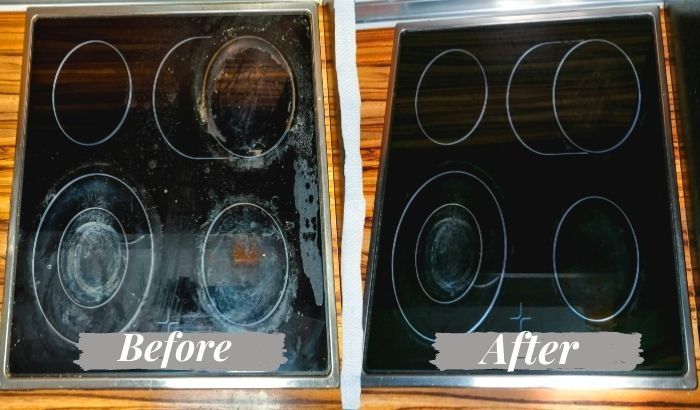
How to clean the oven of your wood stove top
Ovens are usually made of enameled or painted steel or cast iron. To avoid scratching them, you should avoid using abrasive or abrasive home remedies.
- Instead, mix sodium bicarbonate, a little vinegar and water.
- Pour the paste onto a tea towel.
- Rub it on the oven of your galley oven.
- Let the whole thing take effect for a few minutes.
- Then wash the whole thing off with a damp sponge.
- Finally, cleanse the oven dry.
Alternatively, you can use commercially available oven detergents, which also get rid of heavy dirt.
Don’t forget: Clean the flue regularly
Soot and ash settle in the flue. To ensure full performance, the flue of your wood oven must be scrubed regularly. You have two options to access the smoke pipe:
- About the scrubing hole: Most wood oven models allow you to get rid of the oven top, giving you access to the stove pipe. You can vacuum or sweep out the upper part.
- Get rid of the stove pipe : If there is no scrubing opening or it is very dirty, you should get rid of the flue of your galley oven and cleanse it thoroughly with a oven pipe brush.
In most wood-burning ovens, there is another flue around the heating chamber. This can be accessed either via another scrubing opening or by dismantling the wood oven floor.
Sweep out the combustion chamber
You should cleanse the combustion chamber regularly – every three days depending on use – so that the oven burns well. You can get rid of deposits with an ash vacuum cleaner, chimney broom or dustpan. If the combustion chamber lining is made of fireclay, cleanse it carefully with a small spatula so that the stones do not break. You can just as easily brush off the flat or shaking grate.
Does your wood oven have a viewing window?
The chimney window in front of the combustion chamber can also quickly become dirty due to heavy soot formation. You can use special cleaners or simply use the ash from the combustion chamber:
- Take a damp rag and dip it lightly into the ashes.
- Then brush over the viewing window in circular movements.
- Then wipe with clean water and polish dry with a clean rag.
Good to know: Soot marks on the viewing window are caused by heating wet wood. In order to keep soot formation as low as possible, the firewood should not exceed a moisture content of 18%.
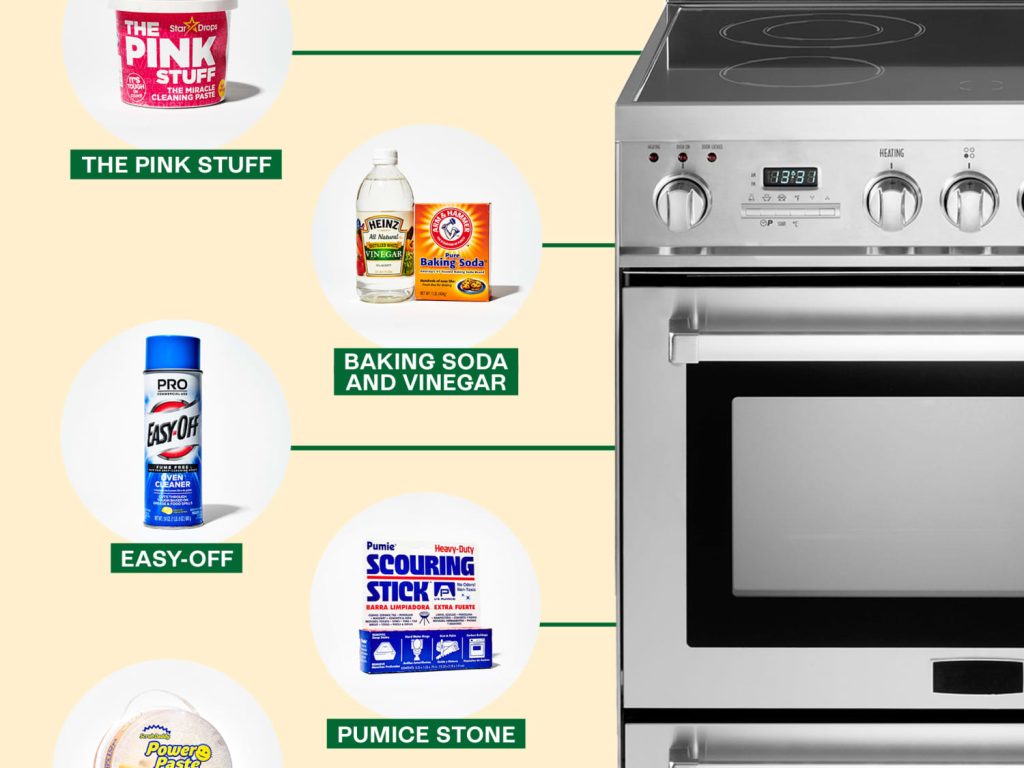
Clean all around: How to clean the cladding of your kitchen oven
Depending on the material used, different scrubing products are used for the cladding of the wood stove.
- Is the cladding on your galley oven ceramic or enamel? Dampen a soft rag with a little soapy water and cleanse the dirt in circular movements.
- If you have steel or cast iron cladding, you should only cleanse it with a soft rag. Dampen the rag with warm water.
- If the cladding of the wood oven is powder-coated, you can also use a rag moistened with soapy water.
- With natural stone, the correct scrubing of your galley oven depends on whether it is sanded or unpolished:
- Unpolished natural stone: It is best to use sandpaper. Conventional rags could form lint.
- Polished natural stone: The best choice is a soft rag with a little soapy water.
How do I remove greasy stains from the oven?
Grease marks and food residue on the hob cause stubborn deposits that are not only unpleasant to the eyes, but also unpleasant to cleanse. Conventional detergents take time to effectively “suck” and get rid of stubborn dirt.
There is a trick that will make constant scrubing easier and ensure that your hob shines like new.
An effective foil trick
Solving your problems may be easier than you think – all you need is a thin, sticky film. This trick uses the properties of oven detergents and foil to get rid of stubborn marks from the oven.
How it works? Use a thick layer of oven detergent to the oven exterior. Then place a piece of thin cling film over it and press it onto the wet exterior.
Thanks to the foil, the detergent does not dry out, works longer and is therefore more effective. Allow the detergent to work for a few hours to 24 hours and then simply remove the film. The film also removes grease marks and dirt. Then simply cleanse the hob surface with a damp rag.
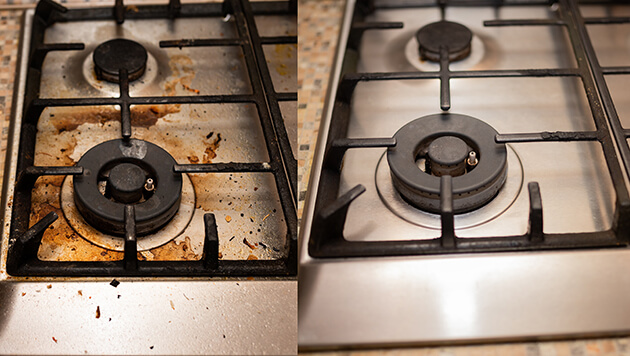
Wipe burnt-in stovetops with cleaning products
Once food residue has burned into the cooktop, it is difficult to get rid of it again. Regardless of whether you want to cleanse a new or old cooktop, simple scrubing products can help you with burnt-in items :
- Kitchen detergent
- Oven spray
❗ Attention: In the worst case scenario, a dirty cooktop has a negative impact on your electricity bill and can lead to a loss of up to 50% of energy when cooking.
Take the galley detergent or oven spray and use it to the switched off cooktop. Now let the whole thing take effect for at least half an hour and then get rid of the dirt with a rag and very warm water. Below you can find out what you need to pay attention to with the different types of ovens.
For heavier dirt, take a scouring pad and use a little detergent to decontaminate the burnt cooktop.

Decontaminate the cooktop with home remedies
If you want to avoid chemical detergents for the sake of the environment or your wallet, you can also use various home remedies to decontaminate the cooktop:
Clean the cooktop: Baking soda as a degreaser
Baking soda is one of the most effective scrubing aids and an all-purpose weapon against dirt in the household. The CO2 that is released when sodium bicarbonate comes into contact with water or acid causes the dirt to come off the cooktop. Here’s how you can quickly and easily clean your electric oven with sodium bicarbonate:
- Dissolve 2-3 tablespoons of sodium bicarbonate in 100 ml of water
- Apply the mixture to the stovetop with a swab
- After allowing it to take effect for ten minutes, get rid of the sodium bicarbonate mixture with a clean wiper and cleanse with a damp cloth
Clean oven with sodium bicarbonate
Mix the sodium bicarbonate (similar to baking powder) with a little water to form a paste and use the paste to the stovetop. Leave the mixture to work for an hour and then get rid of it with a damp cloth. Finally, cleanse with clean water.
Sterilize the cooktop with lemon
You can also sterilize your cooktop with lemon. Add the undiluted lemon juice to the hot plate and let it work for 10 minutes. Any incrustations will then be softened and you can easily cleanse them off. The lemon juice also works against limescale marks on the cooktop.
FAQs
Q: How can I clean a greasy stove?
A: To sterilize tough grease on your oven top, you can use a mixture of hot water and dish soap, or a sterilizing product specifically designed for grease removal.
Q: What is the best way to get rid of caked-on grease from my electric cooktop?
A: You can get rid of tough, caked-on grease from your electric cooktop by soaking the affected area in hot soapy water or using a paste made from sodium bicarbonate and water to scrub the lubricant away.
Q: Should I use a razor blade to scrape off lubricant from my greasy stove?
A: It is not recommended to use a razor blade to scrape off lubricant from your oven top, as this can scratch the exterior and cause damage. Instead, opt for safer sterilizing methods such as using a plastic scraper or a non-abrasive swab.
Q: Can I use ammonia to sterilize the lubricant off my oven top?
A: Ammonia can be used to sterilize lubricant off your oven top, but it should be used with caution and in a well-ventilated area. Always follow safety guidelines and manufacturer’s instructions when using ammonia as a sterilizing agent.
Q: How can I prevent lubricant buildup on my oven top?
A: To keep your oven top sterilize and lubricant-free, make sure to wipe up spills and splatters as soon as they occur, and regularly sterilize the exterior with a lubricant-cutting cleaner or a homemade solution of hot water and dish soap.
Q: What is the best way to sterilize an electric cooktop without scratching it?
A: To sterilize an electric stovetop without scratching it, use a non-abrasive swab or a soft cloth and a gentle detergent specifically formulated for electric stovetops. Avoid using abrasive scrubbers or harsh chemicals that can damage the exterior.
Q: How do I sterilize tough lubricant without spending a lot of time?
A: If you don’t have the time for intensive sterilizing, you can use a lubricant-cutting detergent or a homemade solution of hot soapy water to quickly get rid of tough lubricant from your oven top.
Q: Can I use a magic eraser to sterilize lubricant off my oven top?
A: While a magic eraser can be effective to get rid of tough grime and debris, it is important to use it with caution to avoid accidentally scratching the exterior of your oven top.
Q: How can I safely get rid of burnt-on lubricant from my oven top?
A: To safely get rid of burnt-on lubricant from your oven top, you can use a gentle scrubbing pad or a paste made from sodium bicarbonate and water. Avoid using abrasive tools or harsh chemicals that can cause damage.
Q: What is the best way to sterilize lubricant spatter from my electric oven?
A: To sterilize lubricant spatter from your electric oven, use a mild dish soap and hot water to gently wipe away the splatter. Avoid using abrasive detergents or rough scrubbers that can scratch the exterior.

